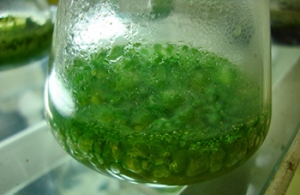2006, DOI: 10.1093/jxb/eri286
The environmental plasticity and ecological genomics of the cyanobacterial CO2 concentrating mechanism
Abstract
 Cyanobacteria probably exhibit the widest range of diversity in growth habitats of all photosynthetic organisms. They are found in cold and hot, alkaline and acidic, marine, freshwater, saline, terrestrial, and symbiotic environments. In addition to this, they originated on earth at least 2.5 billion years ago and have evolved through periods of dramatic O-2 increases, CO2 declines, and temperature changes. One of the key problems they have faced through evolution and in their current environments is the capture of CO2 and its efficient use by Rubisco in photosynthesis. A central response to this challenge has been the development of a CO2 concentrating mechanism (CCM) that can be adapted to various environmental limitations. There are two primary functional elements of this CCM. Firstly, the containment of Rubisco in carboxysome protein microbodies within the cell (the sites of CO2 elevation), and, secondly, the presence of several inorganic carbon (Ci) transporters that deliver HCO3- intracellularly. Cyanobacteria show both species adaptation and acclimation of this mechanism. Between species, there are differences in the suites of Ci transporters in each genome, the nature of the carboxysome structures and the functional roles of carbonic anhydrases. Within a species, different CCM activities can be induced depending on the Ci availability in the environment. This acclimation is largely based on the induction of multiple Ci transporters with different affinities and specificities for either CO2 or HCO3- as substrates. These features are discussed in relation to our current knowledge of the genomic sequences of a diverse array of cyanobacteria and their ecological environments.
Cyanobacteria probably exhibit the widest range of diversity in growth habitats of all photosynthetic organisms. They are found in cold and hot, alkaline and acidic, marine, freshwater, saline, terrestrial, and symbiotic environments. In addition to this, they originated on earth at least 2.5 billion years ago and have evolved through periods of dramatic O-2 increases, CO2 declines, and temperature changes. One of the key problems they have faced through evolution and in their current environments is the capture of CO2 and its efficient use by Rubisco in photosynthesis. A central response to this challenge has been the development of a CO2 concentrating mechanism (CCM) that can be adapted to various environmental limitations. There are two primary functional elements of this CCM. Firstly, the containment of Rubisco in carboxysome protein microbodies within the cell (the sites of CO2 elevation), and, secondly, the presence of several inorganic carbon (Ci) transporters that deliver HCO3- intracellularly. Cyanobacteria show both species adaptation and acclimation of this mechanism. Between species, there are differences in the suites of Ci transporters in each genome, the nature of the carboxysome structures and the functional roles of carbonic anhydrases. Within a species, different CCM activities can be induced depending on the Ci availability in the environment. This acclimation is largely based on the induction of multiple Ci transporters with different affinities and specificities for either CO2 or HCO3- as substrates. These features are discussed in relation to our current knowledge of the genomic sequences of a diverse array of cyanobacteria and their ecological environments.
